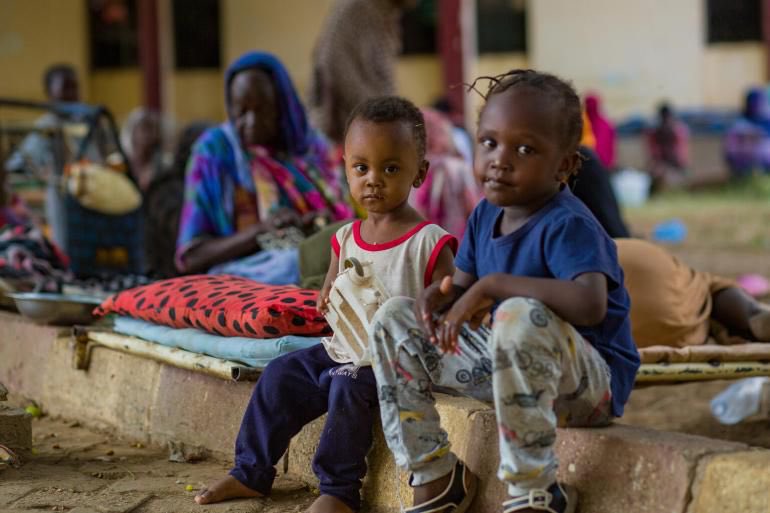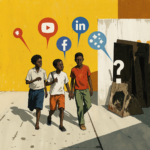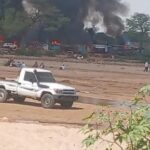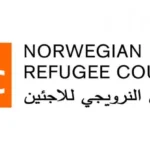Investigation : Darfur follow ups
No one can describe their pain accurately when reading the eyes of children displaced by war. In this investigation, we tried to embrace their silent gentleness and their great sorrows without hesitation, as children in Sudan are still dying and facing grave psychological dangers.
The tragedies of war did not end with the arrival of children to a safe land, as many of us believe. The ravages of war and its psychological effects may appear clearly in their daily behavior and affect their future. The poverty that suffocates families while watching their children bleed from within their hearts, and the stories of many families are similar in areas of war and conflict. The images of children’s suffering in areas where bullets ring out are the same.
“Rawan” a four-year-old girl, We met her family after their house was destroyed by random shells in Nyala, Al-Wadi neighborhood.
Her mother and two brothers remain from her family. She is a child who does not know the meaning of death despite her innocence, but she is afraid of the sounds of bullets, as are her brothers Saad and Monzir, who if they heard someone knocking on the door.
They desperately run into their grandmother’s room and take shelter under the beds, fearing the death that haunts their imagination.
Fatima took her children to a remote area west of Nyala, which is her hometown, where her mother and siblings are located.
After she lost her husband and her child on two consecutive days, the girl died from a bullet that hit her in the abdomen, then the father followed her as a result of a shell that fell in a room in their house, destroying it completely.
We tried to talk to Monzir and his brother Saad, but our attempts failed because they were afraid of every stranger.
“Where is my father?” followed by screaming. With these words, Rogaya has woken up every day since she saw her father, a “corpse,” among a group of corpses in El Geneina, western Sudan, last April, and she, too, did not understand the meaning of death.
To the sounds of bullets, the screams of neighbors, and rising smoke, the 7-year-old girl, Rogaya, begins her day with questions that no one has answered yet. She lives her days in the refugee camps in eastern Chad with these questions after her father was killed. Her wound also bleeds after she was hit by a stray bullet. While she was escaping with her mother in an attempt to survive, they were the others.
After she became accustomed to her father’s return every day, her joy turned into frightening pain and an unknown future. The joy of waiting turned into panic and fear.
“Rogaya” says that she lost her birds and lost her paintings hanging on the walls of her small room. She adds, “They killed them like my father,” and her mother, Ahlam, “Rogaya” says. “It seems simple to a girl who escaped from war. She hopes to publish her drawings and aspires to become an employee, give her time to volunteer, and become a doctor to save herself and children from pain.
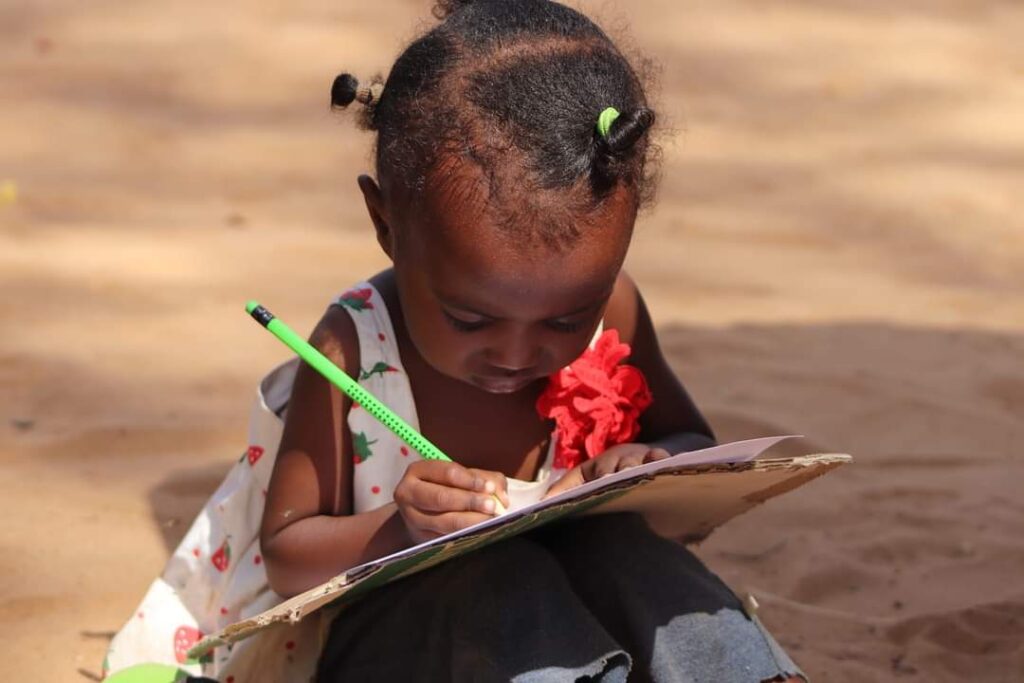
Children who survived death tell their stories
Dozens of stories of children who talked about their feelings of deprivation and the loss of their homes and relatives that served as a safe haven for them, some of whom were internally displaced and some of whom migrated outside the country as refugees in refugee camps, and many concerns expressed by the children.
“Issam” wants to become a defense lawyer in the future. About the oppressed and oppressed who have no voice in their lives. Issam, who is 5 years old, lost his entire family after rocket shell fell in their home in the city of Nyala in South Darfur. He now lives with his relatives, according to his uncle’s narration. He wakes up every day with fear of rocket shell’s sound. That stole his father, his mother, and two of his sisters from him.
“Issam” started the conversation when we asked him what he thought? His eyes filled with tears. He remained silent and his tears spoke of everything. Not a minute passed without Issam shaking in fear before he burst into tears. This was the shock of the sounds of the cannons and explosives that still haunted him.
I was unable to find a suitable way to deal with my three children, which hurts me all the time.”
This is how “Sarah” described her situation after she fled Khartoum with her children in search of safety and security, and she was forced to leave Sudan overnight due to a death threat her husband received.
“Sarah” says, “The decision to leave Sudan was not easy for me, especially since we were leaving Khartoum for the first time. We were forced to do so. We moved with my husband and my three children, the youngest of whom was 3 months old,” but our biggest problem is my son, “Ahmed.” The 9-year-old did not accept it at all. Not only that, but he became aggressive and accused us of keeping him away from his friends and his grandmother.
“Sarah” says that her son carried a small suitcase on his back, burdened with memories of a childhood distorted by war, along with great fears, fleeing along the path that others took, no less difficult and dangerous than the bloody events from which they fled.
She added, “I tried to talk to him about adapting to the new way of life after arriving in Uganda, but to no avail. He went on a hunger strike and raised his voice against his father, which increased our concern for him. She added, “I became harsh with him because of my anxiety and began to beat him.
This risk in itself constituted a severe psychological shock for “Ahmed.” However, the scenes of the violations they were exposed to on their way from Khartoum to Kampala were the greatest shock to him, in addition to seeing tanks and hearing the various continuous sounds of roaring, and other images and videos of war and death spread on social media that did not go unnoticed. This child had compassion for the bitter psychological impact even after his arrival in Uganda.
Symptoms of post-traumatic stress appeared on him, represented by nightly nightmares, fear, anxiety, and a desire for isolation. His psychological state worsened and led to suicide after he took medical drugs in quantities that immediately poisoned him. Ahmed’s mother says that her son only needed a large, safe yard and a ball. He was provided with a safe environment to live a happy childhood and grow up like other children, instead of a school bag full of books and notebooks, but he died early “because of us and the cause of the war.”
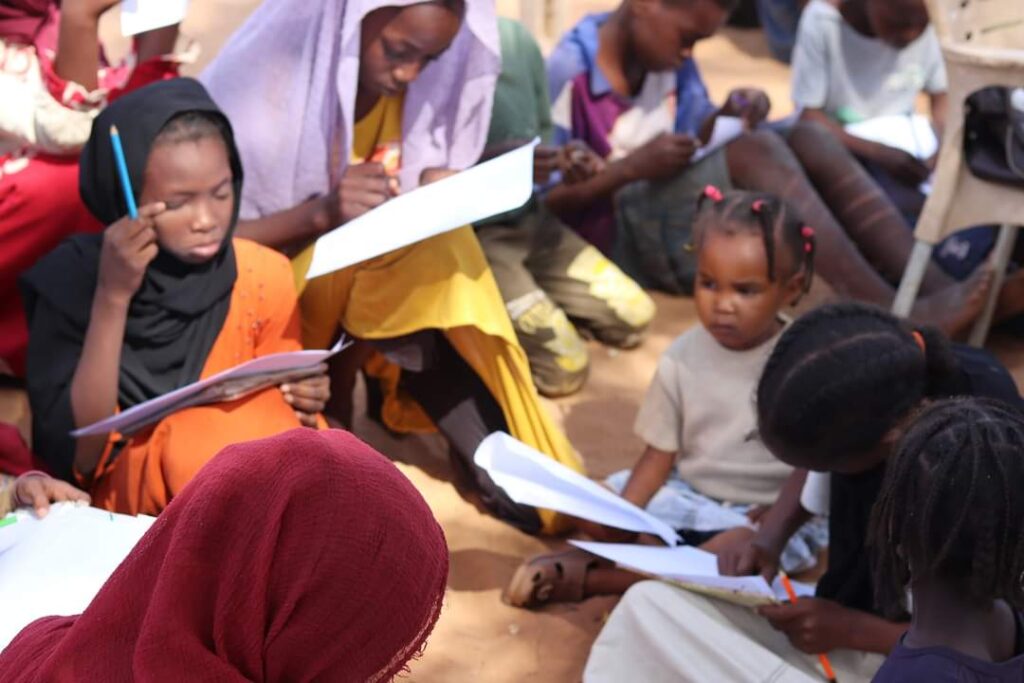
According to the statements of organizations working in the fields of human rights and monitoring and documenting violations in Darfur, 1153 children were killed during the April war currently taking place in the states of North, West, South, and Central Darfur in the period from May to October , and these statistics are inaccurate and the number may be more. According to circulating reports, cases of severe psychological disorders were also monitored for 11 children in North and South Darfur states, according to Abdel Nasser Andi, the coordinator of the civil laboratory in North Darfur state. These statistics were only in the centers (Tana’am, Dar Al-Naeem, Al-Qumma, and Tambasi) in the city of El-Fasher, to which I fled. Many families are from South Darfur state, and it is stated that these statistics are inaccurate. It was stated that most of the cases have not yet reached the seriousness stage, and that they have not communicated with them directly, but are being transferred to psychological support centers at the Saudi Hospital in El Fasher.
Summary of oppression: My children’s lives and dreams have been lost. I no longer understand the world except that I am a refugee.”
“I have suppressed in my eyes the whispers of my children. Their lives have been lost, their dreams have been lost, and I no longer understand the world except that I am a “refugee” without an identity, and then that I am from a destroyed country.” “Majid” summed up his pain with these words as he was “burying” the piece of his liver that was killed after rocket shell fell in… The door of their house in the city of El Fasher, North Darfur. “Majid,” who is now a refugee in South Sudan, says, “My 12-year-old son was very afraid of the sounds of bullets, and when the events occurred in El Fasher, he was urging me to leave, but we refused. He was at the street door with my brother.” The eldest, but a rocket shell fell and killed them before leaving El-Fasher.” He added, “My young children are still in shock because they saw how the pieces of their brother’s body were scattered.” I always ask God to take my soul and relieve me of this pain and fear. I lost my son and my brother. . I have my tragedy in my cold hands and my torn clothes, and in my little heart are their memories, and I took refuge here. Fear and loneliness are still eating me from the inside, and I don’t know if this is my last embrace with my children or if the story has the rest?
An uncertain future
“Souad,” in her thirties, from the city of Zalingei, Central Darfur State, and a mother of four children, says that as a mother she feels very afraid for her children and tries to protect them inside the house, as she considers going out and being displaced very “difficult” for her, and in this war there is no safe place at all, and through the experience of displacement that she lived in Past wars.
Her daughter, “Reem,” still remembers those moments, and every day she says to her, “We don’t want to leave the house.
I don’t want to die outside our house.” She feels that weapons are chasing anyone who walks in the street, because we lived these moments before, and she is afraid of that. At night, she is terrified by the sound of munitions.
“I feel like my whole body hurts because of trying to hide my sadness and crying for my children.”
“Rabia,” a thirty-year-old mother who was displaced to Rehead al-Berdi in South Darfur, says that mothers are living in a difficult situation in the war, so they must be strong in front of their children.
She adds: “I feel like my entire body is aching because of trying to hide my sadness and crying from my children. I try to be strong in front of my children.” “No place is safe,” she adds. “My children are my life.”
Challenges facing children of war
Children in emergencies and conflicts are affected by situations that pose harmful risks to children’s health, safety and well-being.
There are different types of conflicts and emergencies, for example, violence, armed conflicts, war, natural disasters and others. There are approximately 13 million children displaced by armed conflict and violence around the world. When violent conflicts are the norm, the lives of young children are severely disrupted and their families face great difficulty in providing the sensitive and appropriate care that young children need for their healthy development.
Studies on the impact of emergencies and conflict on the physical and mental health of children between birth and 8 years show that where the disaster is natural, The rate of PTSD occurs anywhere from 3 to 87 percent of affected children. However, rates of PTSD in children living in chronic conflict settings range from 15 to 50 percent, as seen in the following countries: Iran, Iraq, and Israel. Kuwait, Lebanon, Palestine, Rwanda, South Africa and Sudan.
Children in war zones may act as perpetrators and become child soldiers. It is estimated that there are about 300,000 child soldiers worldwide and 40% of them are girls. Children are also victims of armed conflicts. They are forced to vacate their homes and work as child soldiers, suffer from sexually transmitted diseases and are denied educational opportunities.

The war hinders the provision of requirements for children and their families, such as food, water, shelter, health services, and education. Failure to reach these basic requirements may deprive children of their physical, social, emotional and psychological development.
In the case of South Sudan, ongoing violent conflicts coupled with climate shocks have caused significant damage to the agricultural-based economy; As a result, more than 1.1 million children suffer from severe food shortages.
More than 2.5 million children suffer from severe acute malnutrition in countries across Africa and the Middle East. Economic sanctions, such as trade restrictions imposed on the international community and international organizations, may play a role in serious economic hardship and deterioration of infrastructure in areas of armed conflict.
This is what makes children’s survival so difficult because they usually live at the lowest level of socio-economic status
Sexual violence
The United Nations defines the term “conflict-related sexual violence” as “rape, sexual slavery, forced prostitution, forced pregnancy, forced abortion, forced sterilization, forced marriage, and any other form of sexual violence of similar gravity committed against women, men, girls or Boys who are directly or indirectly linked to the conflict.” More than 20,000 Muslim girls and women have been raped in Bosnia since 1992.
Many cases were found in Rwanda, where every teenage girl who survived combat was raped. Sexual violence also causes the spread of sexually transmitted diseases – such as HIV/AIDS – one of the factors causing this is involvement with military forces because they assault and sexually exploit girls and women during conflicts. In addition, HIV/AIDS tends to spread rapidly as HIV-infected mothers give birth to HIV-infected infants without antiretroviral drugs.
The destruction of schools during wars also results in disruption of education (cessation of studies). Human and financial resources are at risk during a crisis. The United Nations reports that more than 13 million children have been deprived of educational opportunities and more than 85,050 schools have been destroyed due to armed conflicts in the Middle East.
According to a UNICEF report, 1.8 million children dropped out of school in 2015 in Yemen. About half a million children in the Gaza Strip were unable to go to school due to damage to schools between 2014-2015. More than three million children cannot go to school due to conflicts in Sudan.
About 45% of primary schools were destroyed during the conflict in Mozambique. Fear and confusion make it difficult for both children and teachers to focus on learning. This creates an educational gap, as children are deprived of basic education, building social and emotional skills, and are thus unable to reintegrate into society. In addition, gender equality can also be threatened with the exception of girls’ overall interruption of schooling in areas of armed conflict.
The use of rape as a tool of war
On the twenty-fourth of November, the Rapid Support Forces kidnapped two minor girls, aged 15 and 13, in front of their mother in the Al-Safa neighborhood in Kalakla in the capital, Khartoum, according to a statement from the Strategic Initiative for Women of the Horn of Africa (Sayha Network).
Eyewitnesses reported that the Rapid Support Forces stormed the house. In the Al-Safa neighborhood at night, they kidnapped the two girls by force, after threatening all the residents of the house with weapons, and the attempts of family and friends have not succeeded in finding the two girls so far.
Enas Muzamil, an activist who works with rape survivors in Khartoum, told guardian newspaper that receiving post-rape care has become a “privilege.” She added that underage girls communicate through their families through groups on social media, and exchange the resources and medicines they obtain.
She added, “Many girls resort to traditional methods such as herbal vaginal douches.”
She said: I know a sixteen-year-old girl who was raped by three men, and she did not know whether she was pregnant or not. She was not able to get the right medication.
Muzamil said that the family of a 17-year-old girl who had been raped contacted her for help. She said that the girl’s family told her that members of the Rapid Support Forces “raided the house, found the girl sleeping, and raped her.”
In a related context, Arif Nour, director of Save the Children in Sudan, said in a statement, “We know that the official numbers are just the tip of the iceberg. Girls as young as 12 are being targeted because of their gender, race or vulnerability.
Nour added that some fathers marry their daughters at a young age in an attempt to protect them from attacks, especially in areas of displacement.
Relief organizations and officials revealed that the conflict between the two armed parties in Sudan has caused an increase in cases of rape and kidnapping of girls, some as young as 12 years old.
Save the Children said in a statement that armed fighters from the Sudanese Armed Forces were sexually assaulting and raping teenage girls in “alarming numbers,” while the United Nations reported a “marked increase” in gender-based violence.
Traumas from which no child survived
Psychological experts say that the trauma caused by sexual violence can have long-term physical, psychological, social and economic effects. The brutality of the physical act itself can be especially harmful to children whose bodies have not yet fully developed, and girls may suffer from uterine prolapse, fistulas and other injuries to their reproductive systems. They face complications and death due to early pregnancy and unsafe abortion.
Both boys and girls are at risk of damage to the urinary and anal tracts, and exposure to sexually transmitted diseases that, if left untreated, can cause long-term harm and even death.
The mere threat of sexual violence can cause entire communities to flee their homes. Victims/survivors of sexual violence are at risk of contracting HIV and other sexually transmitted diseases and may also suffer potentially lifelong psychological consequences and impacts due to the stigma associated with this form of violence.
Abdullah Adam Yassin, a psychological researcher and lecturer in the Department of Psychology, College of Humanities, University of Bahri, says about post-traumatic stress disorder in children: It is a painful disorder that leads to disability that lasts for weeks, months, or years. This disorder appears when threatened with death or severe harm, and this is what leads to disability.
He mentioned Many researchers have indicated that children are directly affected by political violence, and pointed out that children in Sudan have been affected by political violence since the beginning of the wars in Sudan.
At the beginning of his analysis, he cited the participation of children in the General Command sit-in. He also mentioned that post-traumatic stress disorder is similar to symptoms of psychological stress, and he believes that the reasons that cause children to develop post-traumatic stress disorder are seeing wounds, hearing painful news, or having nightmares, whether related to the event or far from reality, which It creates irritation in the child and leads to emotional dullness. Which results in depression, anxiety, tension, and a constant feeling of fear, which results in physical intolerance.
He mentioned that he met a child crying during his family’s displacement from one place to another due to the war, and his imagination was working in the context of his longing for his memories and friends and how to get them back again.
In addition to the secondary manifestations, depression, anxiety, stress, fear, and physical intolerance occur. He said, “We find that children from 7 to 12 years of age are able to benefit from their social, emotional, and mental skills, as cognitive development begins to form in them.”
He added, “For example, in the case of refugees, there are children who do not want to leave their homes, friends, and schools, due to their emotional and psychological attachment to places and people. Symptoms of shock appear in visual recall of events in drawings and writings about violence, and forgetfulness and an imbalance in the arrangement of events occur, and a decrease in their narratives in a way.” Unconscious and forgetfulness turns into a defense mechanism.
There is also an increase in fear and tension, a decline in behavior as the child turns into a violent personality, a decrease in the ability to concentrate in school, and an increase in anger and behavioral and verbal violence.
He pointed out the type of trauma that may accompany children during war, such as a single traumatic event in which memories are present and its duration is long. In the treatment process, the person is excluded from the area in which the event occurred. The second model is traumatic events that last and are repeated, indicating the characteristics of post-traumatic stress disorder in Children are represented by memories and visual images associated with the event, repetition of emotions and actions, such as in play, and fears related to trauma. He adds that negative life towards people and the future is formed in the child’s imagination.
He said that there are factors that lead to the emergence of the disorder, which are intolerance, lack of social and psychological support, and low economic standards, especially since everyone focuses on older age groups without taking into account the situation of children.
He added that the poor psychological state of the child when he is young bears more psychological energy than he can handle, and when a traumatic event occurs in front of him that he cannot react to, the process of emotional dulling occurs due to the collective unconscious of socialization, which imposes on him tolerance. Therefore, the psychological load must be balanced by age.
The Sudanese specialist in the field of childhood rights and protection stated that most children in war zones have been exposed to high rates of terror given their ages and experiences during which they had not witnessed such atrocities before, which caused major psychological shocks to a wide sector of those who could be called “children of war.” “On them, who spent the first weeks amidst the fires of fighting and battles, and began to suffer from psychological terror, nightmares, hallucinations, and obsessions.
Adel Al-Amin Yahya stated that, in addition to the psychological and social repercussions, children in Khartoum and other battle areas are exposed to the danger of unexploded projectile remnants resulting from the outbreak of clashes in residential neighborhoods, which constitute an extremely dangerous threat to children, and the relevant authorities and organizations must deal with them immediately with the required speed.
In South Darfur state, the leadership of the 16th Infantry Division of the Sudanese army in the city of Nyala, the state capital, accused some civil leaders of involvement in recruiting minor children to fight in the ranks of the Rapid Support Forces. The division announced the arrest of members of the Rapid Support Forces, including minor children who had been recruited by them. Some tribes were baptized to fight, and a video published by media outlets documented testimonies of those arrested that the reasons for recruitment were to obtain money and salaries, according to what the tribal mayors told them.
The 16th Division called on the Red Cross to receive the arrested children and hand them over to their families, calling on the Rapid Support Forces, mayors, and tribal sheikhs to come to their senses, stop recruiting this age group, and not throw them into battles.
In the city of El Geneina in the state of West Darfur, children were recruited within the armed movements, Rapid Support, and the Sudanese army to actually fight. Videos published during the recent events documented children carrying weapons and fighting against the army before the Rapid Support took over the army headquarters in El Geneina. Videos also spread proving the involvement of the armed forces. The Sudanese coalition forces in West Darfur used children as human shields in the recent battles in the Ardamata area.

Reports expose the brutality of war
The UNHCR reported that 1,200 children under the age of five died in Sudanese refugee camps between May and September due to measles and malnutrition in nine refugee camps in Sudan since May, and the Secretary-General of Amnesty International, “Anis Calla Mar” indicated that dozens of girls, who had not They are over 12 years old and subjected to rape and other forms of sexual violence at the hands of warring parties on both sides
The United Nations Children’s Fund (UNICEF) says it has received worrying reports about the recruitment and use of children in the ongoing war in Sudan, and the organization pointed out that the number reported due to gross violations of children’s rights in Darfur has risen to 450 percent compared to the number verified the previous year. , noting that of all the incidents of killing and mutilation reported throughout Sudan, 51 percent of them involve children in Darfur, and 48 percent of the total cases of sexual violence reported in the country occur in Darfur.
The organization’s Executive Director, Catherine Russell, pointed out that Sudan, and Darfur in particular, has become “a living hell for millions of children, as thousands are being ethnically targeted, killed, injured, abused and exploited, which requires stopping this matter.” She explained that “these children are suffering from new violence, while there is no Their fathers and grandfathers still bear the scars of previous cycles of violence.
She adds that teenage girls are being sexually assaulted and raped by armed fighters in Sudan in alarming numbers, with many survivors between the ages of 12 and 17, as incidents of rape, sexual assault and sexual exploitation have been reported by women and girls who have fled the conflict. In Khartoum and other areas in Darfur
She stated that there is an urgent need for urgent humanitarian intervention for 14 million children in Sudan, and that, according to the International Organization for Migration, four million people were forced to flee their homes, with more than 926 thousand people seeking refuge in Egypt, Libya, Chad, Central Africa, South Sudan and Ethiopia. ), and 3.02 million people were internally displaced.
Ms. Mulally, the UN Special Rapporteur on human trafficking, said that the deteriorating humanitarian situation and the lack of access to food and other basic services make children, especially unaccompanied and separated children on the streets, easy targets for recruitment by armed groups, as she put it.
In response to allegations that children may join armed groups as a survival strategy, the Special Rapporteur said that the consent of the child – anyone under the age of 18 – was legally irrelevant, and that it was not necessary to prove the use of force. She said that recruitment of children by groups Armed forces for any form of exploitation, including in combat roles, is a flagrant violation of human rights, a serious crime, and a violation of international humanitarian law.
In North Kordofan, the Secretary of the State Child Welfare Council, Abdel Azim Daw al-Bayt, said that 26 children were killed during the war, in addition to 106 other children being injured, indicating that the number of children inside the displacement camps in the city of El Obeid alone reached five thousand children, in dire need of Humanitarian aid.
In response to the emergency in Sudan, the Education Does Not Wait Fund, the United Nations global fund for education in emergencies and protracted crises, announced the allocation of five million dollars in new funding dedicated to education in Sudan, as a grant for use by Save the Children and UNICEF. With the aim of helping 86,000 girls and boys of school age for one year in each of West Darfur and White Nile states
What you need to do now:
Early Childhood Care and Education (ECCE) is a multi-sectoral field that comprehensively addresses the multiple needs of children. In emergency situations, services supporting early childhood care and education may address a range of issues including antenatal care, immunization, nutrition, education, psychosocial support and community engagement.
Coordinated health, nutrition, sanitation and hygiene, early learning, mental health and protection services are essential to support young children living in emergencies and conflicts.
Many programs and strategies, whether in the formal or non-formal education sector, have proven to be very supportive of the well-being and recovery of children living in conflict areas.
Children’s Safe Spaces (CFS) programs have found benefits in creating a sense of normalcy and providing coping and flexibility skills for children affected by emergencies. Safe spaces also help children develop social skills and competencies such as participation and cooperation through interaction with other children. They also provide opportunities to learn about risks in their environment and build life skills, such as literacy and non-violent conflict resolution, and provide a useful way to mobilize communities around the needs of children.
In an effort to strengthen community child protection systems, the Christian Children’s Fund established three centers for internally displaced children in Onyama camp (Uganda) that provided a safe place, under adult supervision, for children between the ages of 3 and 6 years. War Child created six safe spaces in schools in northern Lebanon for displaced Syrian children, where counselors used art and music therapy to help the young children express their feelings in a healthy way.
Many studies show that children who have participated in quality education programs within schools tend to have better knowledge of risks, lower levels of fear and more realistic perceptions of risks than their peers. In such contexts, psychosocial intervention programs for children and their families are vital. Interventions such as storytelling, singing, jumping rope, role-playing activities, team sports, and writing and drawing exercises helped reduce psychological distress associated with exposure to conflict-related violence in Sierra Leone for children aged 8 to 18 years.
Studies in Eritrea and Sierra Leone have revealed that children’s psychological well-being can be improved through well-designed educational interventions. In Afghanistan, children and adolescents gained a sense of stability and security after participating in constructive activities (such as art, narrative, sports) that took place in safe, neutral spaces within their communities. This is also happening in some shelter centers now in Sudan, in the city of El Fasher in North Darfur State and the city of Madani in Gezira State.

